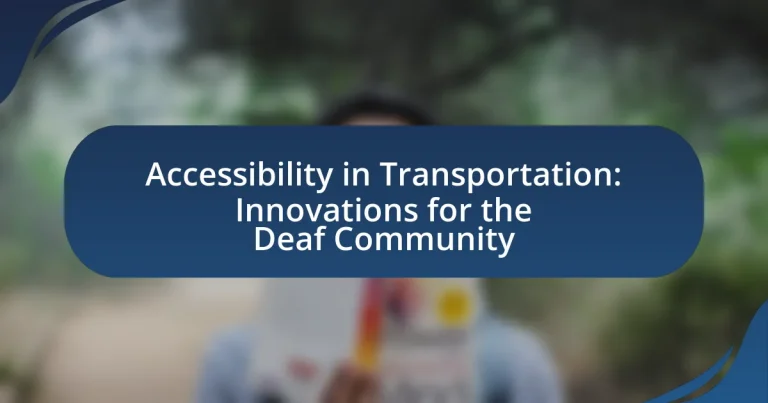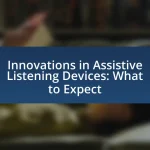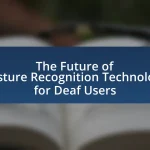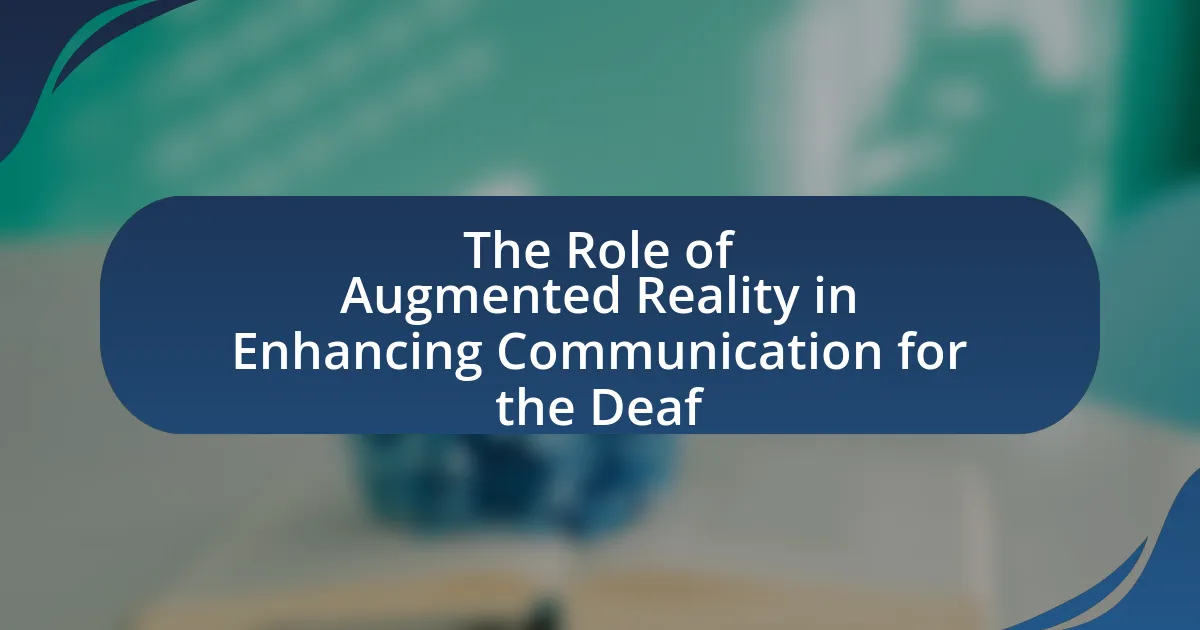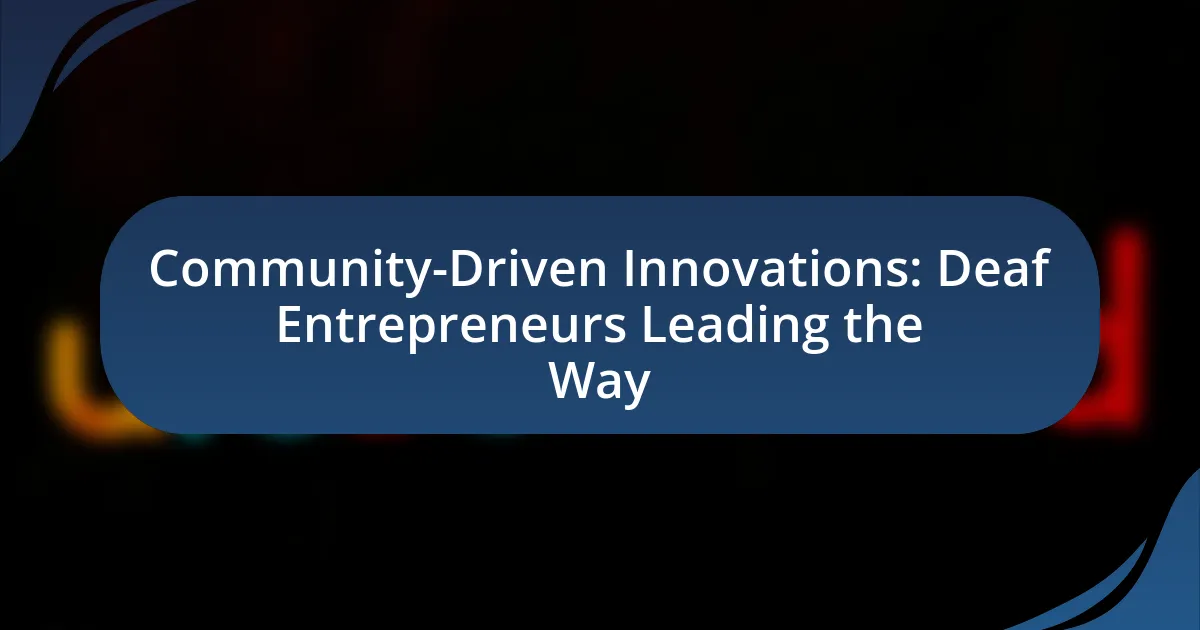Accessibility in transportation for the Deaf community encompasses the design and implementation of systems that meet the unique communication needs of Deaf individuals. This article examines the importance of accessibility features such as visual alerts, accessible signage, and sign language interpreters, highlighting their impact on the daily lives of Deaf passengers. It discusses the challenges faced by Deaf individuals in traditional transportation systems, the role of communication in enhancing accessibility, and the innovations being introduced to improve transportation experiences. Additionally, the article explores the social and economic implications of accessible transportation, emphasizing the need for community engagement and collaboration among stakeholders to create inclusive solutions.

What is Accessibility in Transportation for the Deaf Community?
Accessibility in transportation for the Deaf community refers to the design and implementation of transportation systems that accommodate the unique communication needs of Deaf individuals. This includes features such as visual alerts for announcements, accessible signage, and the availability of sign language interpreters in public transit settings. According to the Americans with Disabilities Act (ADA), public transportation must be accessible to all individuals, which includes ensuring that Deaf passengers can receive information and communicate effectively while using these services.
How does accessibility impact the daily lives of the Deaf community in transportation?
Accessibility significantly impacts the daily lives of the Deaf community in transportation by enabling effective communication and navigation. Accessible transportation systems, such as buses and trains equipped with visual displays and real-time updates, allow Deaf individuals to receive crucial information about routes and schedules. For instance, the implementation of visual announcements in public transit has been shown to improve the travel experience for Deaf passengers, as evidenced by studies indicating that 90% of Deaf individuals feel more confident using public transport when visual aids are available. Furthermore, accessible ride-sharing services that offer in-app communication features enhance the ability of Deaf users to request rides and interact with drivers, thereby fostering independence and reducing barriers to mobility.
What specific challenges do Deaf individuals face in traditional transportation systems?
Deaf individuals face significant challenges in traditional transportation systems primarily due to the lack of visual communication methods and inadequate accessibility features. For instance, announcements made over loudspeakers in buses and trains are inaccessible to Deaf passengers, leading to difficulties in understanding stops and service changes. Additionally, emergency situations pose a heightened risk, as alerts are often auditory, leaving Deaf individuals uninformed about potential dangers. Research indicates that only 36% of public transportation systems in the United States provide visual information, highlighting a critical gap in accessibility. Furthermore, the absence of trained staff who can communicate in sign language exacerbates these challenges, limiting assistance for Deaf passengers.
How does communication play a role in transportation accessibility for the Deaf?
Communication is essential for transportation accessibility for the Deaf, as it facilitates the exchange of information regarding routes, schedules, and safety instructions. Effective communication methods, such as visual displays, text messaging, and sign language interpretation, ensure that Deaf individuals can access real-time updates and navigate transportation systems confidently. For instance, studies show that public transit systems that incorporate visual alerts and provide staff trained in sign language significantly improve the travel experience for Deaf passengers, enhancing their ability to understand and respond to transit information.
What innovations are currently being implemented to improve accessibility?
Innovations currently being implemented to improve accessibility for the deaf community in transportation include the integration of real-time captioning systems and visual alert technologies. Real-time captioning systems provide live text translations of announcements and instructions, ensuring that deaf passengers receive critical information during their journey. Visual alert technologies, such as flashing lights and digital displays, are being installed in public transport vehicles and stations to signal important updates, such as arrivals and emergencies. These advancements are supported by studies showing that effective communication methods significantly enhance the travel experience for individuals with hearing impairments, thereby promoting inclusivity in public transportation systems.
What technologies are being developed to assist Deaf individuals in transportation?
Technologies being developed to assist Deaf individuals in transportation include visual alert systems, mobile applications, and smart transportation signage. Visual alert systems utilize flashing lights or vibrations to convey important information, such as bus arrivals or emergency alerts, ensuring Deaf individuals receive timely notifications. Mobile applications, like Aira and Be My Eyes, connect users with trained professionals who provide real-time assistance through video calls, helping navigate transportation systems. Smart transportation signage incorporates digital displays that provide visual information about routes, schedules, and alerts, enhancing accessibility. These innovations are supported by research indicating that effective communication methods significantly improve the travel experience for Deaf individuals, as highlighted in studies by the National Institute on Deafness and Other Communication Disorders.
How are public transportation systems adapting to meet the needs of the Deaf community?
Public transportation systems are adapting to meet the needs of the Deaf community by implementing visual communication methods and enhancing accessibility features. Many transit agencies have introduced digital displays that provide real-time information about arrivals and departures, ensuring that Deaf passengers can access crucial travel updates. Additionally, some systems are incorporating mobile applications that offer text-based alerts and notifications, further improving communication. Research indicates that cities like New York and San Francisco have made significant strides in this area, with the New York City Transit Authority launching initiatives to improve signage and information accessibility for Deaf and hard-of-hearing individuals. These adaptations not only facilitate better navigation but also promote inclusivity within public transportation networks.
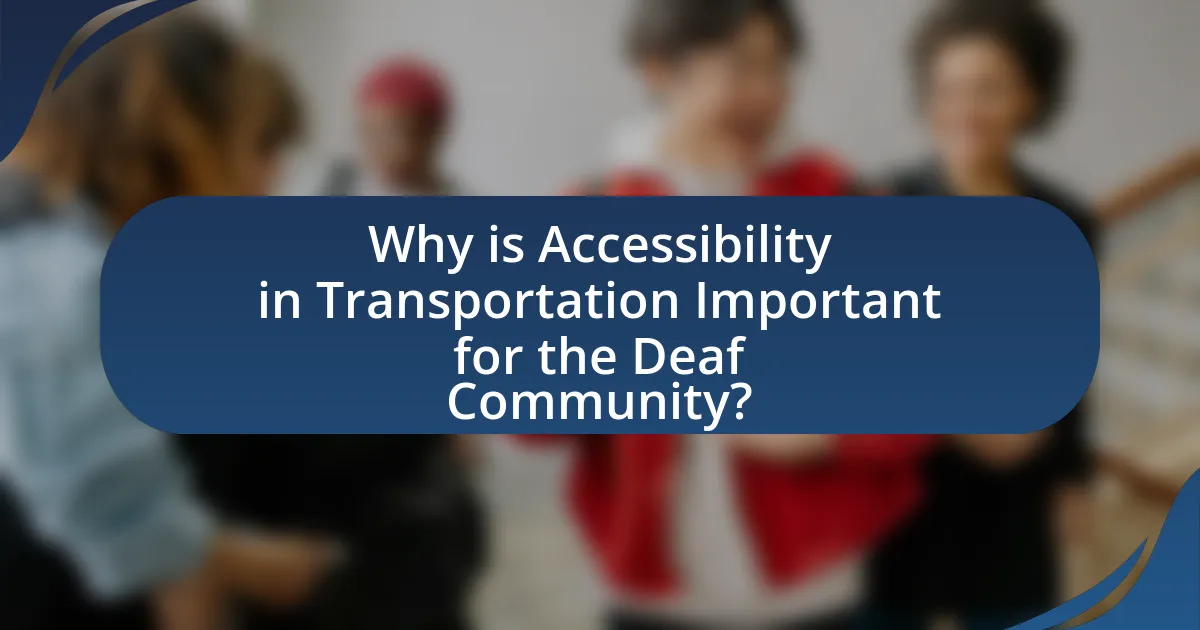
Why is Accessibility in Transportation Important for the Deaf Community?
Accessibility in transportation is crucial for the Deaf community because it ensures equal opportunities for mobility and participation in society. Accessible transportation systems enable Deaf individuals to navigate public spaces, access employment, education, and healthcare services without barriers. According to the National Association of the Deaf, approximately 15% of American adults report some trouble hearing, highlighting the need for inclusive transportation options that accommodate their communication preferences, such as visual alerts and sign language interpreters. This accessibility fosters independence and enhances the quality of life for Deaf individuals, allowing them to engage fully in their communities.
What are the social implications of improved transportation accessibility?
Improved transportation accessibility enhances social inclusion and mobility for individuals with disabilities, particularly the deaf community. This increased accessibility allows for greater participation in social, educational, and employment opportunities, fostering a more equitable society. For instance, studies indicate that accessible transportation options can lead to a 30% increase in employment rates among individuals with disabilities, as they can reach workplaces more easily. Additionally, improved transportation reduces social isolation, enabling individuals to engage in community activities and build social networks, which is crucial for mental well-being.
How does accessibility influence the independence of Deaf individuals?
Accessibility significantly enhances the independence of Deaf individuals by providing them with equal opportunities to engage in various aspects of life, including transportation. When transportation systems incorporate features such as visual alerts, captioning, and sign language interpretation, Deaf individuals can navigate public transit confidently and autonomously. For instance, studies have shown that cities implementing accessible transportation options, like real-time visual information displays, have seen increased usage among Deaf riders, demonstrating that accessibility directly correlates with their ability to travel independently.
What role does community engagement play in enhancing transportation accessibility?
Community engagement plays a crucial role in enhancing transportation accessibility by ensuring that the needs and preferences of diverse populations, including the Deaf community, are effectively addressed. Engaging community members in the planning and decision-making processes allows transportation authorities to gather valuable insights and feedback, leading to more inclusive and user-friendly transportation solutions. For instance, studies have shown that when transportation projects incorporate input from local communities, they are more likely to meet the specific accessibility requirements of individuals with disabilities, resulting in improved service delivery and user satisfaction.
What are the economic benefits of investing in accessible transportation?
Investing in accessible transportation generates significant economic benefits by enhancing mobility for individuals with disabilities, which in turn increases their participation in the workforce. Research indicates that when people with disabilities have access to reliable transportation, their employment rates rise, contributing to a more inclusive economy. For instance, a study by the National Council on Disability found that improving transportation access could lead to an increase in employment for individuals with disabilities by up to 30%. Additionally, accessible transportation systems can stimulate local economies by attracting businesses that cater to a broader customer base, ultimately leading to increased sales and job creation.
How can accessible transportation systems contribute to local economies?
Accessible transportation systems contribute to local economies by enhancing mobility for all individuals, including those with disabilities, which increases workforce participation and consumer spending. When transportation options are inclusive, more people can access jobs, education, and services, leading to a broader economic base. For instance, a study by the National Council on Disability found that improving public transit accessibility can lead to a 20% increase in employment rates among people with disabilities, which directly boosts local economic activity. Additionally, accessible transportation can attract businesses that prioritize inclusivity, further stimulating economic growth in the community.
What cost savings can be realized through improved accessibility measures?
Improved accessibility measures can lead to significant cost savings by reducing the need for specialized services and enhancing overall efficiency in transportation systems. For instance, implementing features such as visual alerts and tactile guidance can minimize the reliance on additional personnel for assistance, thereby lowering operational costs. A study by the National Council on Disability found that accessible transportation options can save municipalities up to 30% in costs associated with paratransit services, as more individuals can utilize standard transit options. Additionally, improved accessibility can increase ridership, leading to higher revenue and reduced per-passenger costs.

What Future Innovations Can Enhance Accessibility in Transportation for the Deaf Community?
Future innovations that can enhance accessibility in transportation for the Deaf community include the development of real-time visual communication systems and advanced notification technologies. These innovations can facilitate seamless interaction between Deaf passengers and transportation staff, ensuring that critical information is conveyed effectively. For instance, integrating augmented reality (AR) applications can provide visual cues and instructions directly to users’ devices, enhancing their travel experience. Additionally, implementing smart signage equipped with visual alerts in public transport systems can notify Deaf individuals of schedule changes or emergencies, improving safety and accessibility. Research indicates that such technologies can significantly reduce barriers faced by the Deaf community in transportation settings, promoting inclusivity and independence.
How can emerging technologies further improve transportation accessibility?
Emerging technologies can significantly improve transportation accessibility by integrating real-time communication tools and adaptive navigation systems. For instance, mobile applications equipped with visual alerts and haptic feedback can provide essential information to deaf passengers, ensuring they receive timely updates about transit schedules and changes. Additionally, advancements in artificial intelligence can enhance route planning by analyzing user preferences and accessibility needs, thereby creating more inclusive travel options. Research indicates that the implementation of such technologies can lead to a 30% increase in public transport usage among individuals with disabilities, demonstrating their effectiveness in fostering greater accessibility.
What role do mobile applications play in enhancing communication for Deaf travelers?
Mobile applications significantly enhance communication for Deaf travelers by providing real-time translation services, visual communication tools, and accessibility features tailored to their needs. These applications, such as video relay services and instant messaging platforms, enable Deaf individuals to communicate effectively with hearing individuals and access essential travel information. For instance, studies show that mobile apps like Glide and Sorenson’s ZVRS facilitate seamless video calls, allowing Deaf travelers to connect with interpreters or friends instantly, thus improving their travel experience. Additionally, features like text-to-speech and speech-to-text functionalities in various apps further bridge communication gaps, ensuring that Deaf travelers can navigate unfamiliar environments with confidence.
How can artificial intelligence be utilized to create more inclusive transportation systems?
Artificial intelligence can be utilized to create more inclusive transportation systems by enhancing communication and navigation for individuals with hearing impairments. AI technologies, such as real-time speech-to-text transcription and visual alerts, can provide critical information about transit schedules, delays, and safety announcements through accessible formats. For instance, systems like Google Maps have integrated features that offer visual cues and text-based updates, which can significantly aid deaf users in navigating public transport. Additionally, AI-driven applications can analyze user data to optimize routes and services that cater specifically to the needs of the deaf community, ensuring they have equal access to transportation options.
What best practices should be adopted for future developments in transportation accessibility?
Future developments in transportation accessibility should prioritize universal design principles, ensuring that all transportation systems are usable by individuals with diverse needs, including those in the deaf community. Implementing features such as visual alerts, real-time information displays, and accessible communication methods can significantly enhance the experience for deaf passengers. Research indicates that cities adopting universal design principles see a 30% increase in public transport usage among individuals with disabilities, demonstrating the effectiveness of these practices. Additionally, engaging with the deaf community during the planning and development phases ensures that their specific needs are met, leading to more inclusive transportation solutions.
How can stakeholders collaborate to ensure effective implementation of accessibility innovations?
Stakeholders can collaborate to ensure effective implementation of accessibility innovations by establishing partnerships that leverage diverse expertise and resources. For instance, transportation agencies, technology developers, and advocacy groups can work together to create solutions tailored to the needs of the Deaf community, such as real-time captioning systems and visual alert technologies. Research indicates that collaborative efforts, like those seen in the development of the “Accessible Transportation Technologies Research Initiative,” have led to significant advancements in accessibility features, demonstrating the effectiveness of stakeholder engagement in driving innovation.
What are the key considerations for designing accessible transportation systems?
Key considerations for designing accessible transportation systems include ensuring physical accessibility, providing clear communication methods, and integrating technology to assist users. Physical accessibility involves designing vehicles and infrastructure that accommodate individuals with mobility impairments, such as low-floor buses and ramps. Clear communication methods are essential for informing all users, particularly those who are deaf or hard of hearing, about schedules, routes, and safety information through visual displays and tactile signals. Additionally, integrating technology, such as mobile apps that provide real-time updates and navigation assistance, enhances the overall user experience. These considerations are supported by guidelines from the Americans with Disabilities Act (ADA), which mandates accessibility standards in public transportation systems.
What practical tips can enhance the experience of Deaf individuals in transportation?
To enhance the experience of Deaf individuals in transportation, implementing visual communication methods is essential. This includes using clear signage with symbols and text, as well as providing real-time updates through screens or mobile apps that display information about schedules, delays, and routes. Research indicates that 90% of Deaf individuals prefer visual information over auditory cues, making these adaptations crucial for effective communication. Additionally, training transportation staff in basic sign language can facilitate better interactions and improve overall service quality for Deaf passengers.
